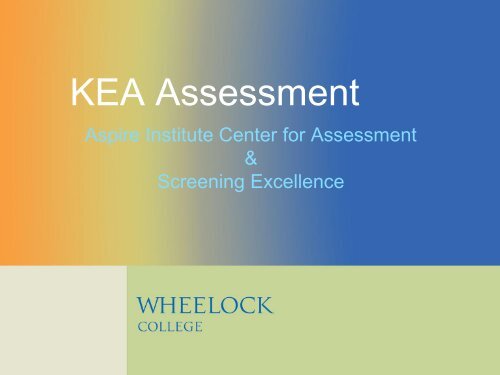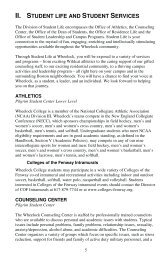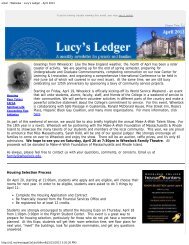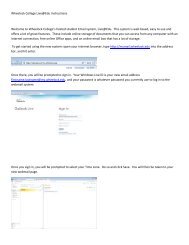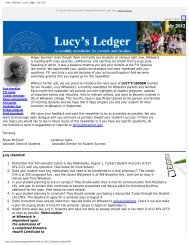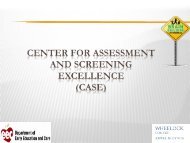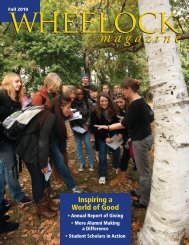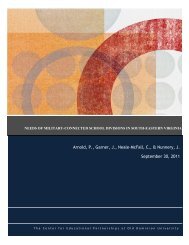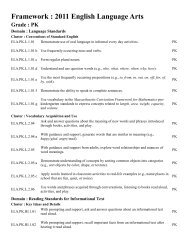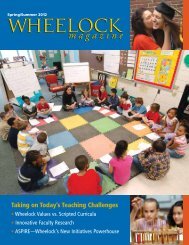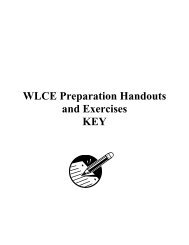Work Sampling System
Work Sampling System
Work Sampling System
- No tags were found...
Create successful ePaper yourself
Turn your PDF publications into a flip-book with our unique Google optimized e-Paper software.
MKEA: Year 2 Expectations• Data collection in the fallrequired; winter and springcollections highly recommended• Data collection across alldevelopmental domains• Assessing all kindergartenchildren
EARLY CHILDHOOD ASSESSMENT SYSTEM• Assessment systems should be aligned withappropriate curriculum and instructionalgoals/practices.• Interconnected components:• assessment of children• adult-child interaction• program measurement• Important and careful decision making in:• selecting instruments• administration• data collection• analysis
ASSESSMENTA dynamic process of collection &synthesizing informationAuthentic assessment gives apicture of the whole child.
Authentic Assessment Defined• A tool or process for answeringspecific questions about variousaspects of children’s knowledge,skills, behaviors or personality.• Root word of assessment comesfrom the Latin word “assis”.
Assessment is more than a toolAssessment is an interconnected systemIntentionalcurriculumplanningInform policyEnabledifferentiatedinstructionEvaluateprogrameffectiveness& measureaccountabilityPURPOSESupportchildren’stransition topublic schoolsystemsSupportteachers’professionalgrowth
Effective assessment methods and tools are…DevelopmentallyappropriateAuthenticFair and InclusiveTied to children’sdaily activitiesDrawn fromMultiple Sourcesof InformationCulturally andlinguisticallyresponsiveSupported byprofessionaldevelopmentConducted inFamiliar Contextsand SettingsInclusive of allchildren andfamiliesReflective ofeverydayrelationships andexperiencesInclusive ofChildren withSpecial NeedsHave Continuity
An Assessment Tool Should…document progress in all areasof child development,including emotional, social,physical, and cognitivedevelopment.can be used to identify andaddress areas where a childneeds further attention.provide educators criticalinformation for curriculumplanning.help educators learn moreabout the children in undertheir care.be used to help educatorscommunicate with families.
Why is this important toclassrooms?• Allows intentional curriculumplanning and guides instruction• Addresses individual needs andenables differentiated instruction• Evaluates program effectiveness• Ensures program accountability
Assessment Guides CurriculumDevelopmentCore of Curriculum Development:Being able to “integrate the children’s needs,interests, and abilities with your conceptualplan for implementing goals and objectives”(Jackman, H.L., 2012).
Linking Curriculum & AssessmentLearningGoalRelatedMaterialsavailable inclassroomareasIntentional&planned playexperiences
TSGold9.D Tells about anothertime: elaborates storesII Language & LiteracyC Reading 4 Comprehends &Responds to stories read aloudWSS
LET’S TAKE A LOOK ATTWO TOOLS….
Teaching Strategies GOLD ®Birth Through KindergartenAssessment <strong>System</strong>A Massachusetts EEC recommended assessment toolCurriculum Assessment Professional Development Family Connection
The Components of Teaching StrategiesGOLD®• Objectives for Development & Learning• Progression of development and Learning• Inclusion (Children with Special Needs,Exceptional Children and English LanguageLearners)• Child Assessment Portfolio• Assessment Opportunity Cards• On The Spot Observation Recording Tool
Assessment Tools to Carry Out the Cycle
Dimensions and indicators help educators tounderstand a child’s learning & developmentthrough a scaffold model.ArtsScience/TechnologyArea ofLearning andDevelopmentSocial EmotionalLiteracyCognitiveObjectiveLanguageDimensionPhysicalEnglish Language AcquisitionIndicatorMathematicsSocial StudiesExample
Area of Learning and DevelopmentArea ofLearning andDevelopmentThere are 10 areas of learning anddevelopment. The first 4 are majorareas of child development:•Social emotional•Physical•Language•CognitiveThe next 5 areas represent content:•Literacy•Mathematics•Science/Technology•Social Studies•ArtsThe last area is:•English Language Acquisition
ObjectiveArea ofLearning andDevelopmentObjectiveAn objective indicates a goal forthe children to achieve in aparticular area of development:•The tool has a total of 38objectives across all the areas oflearning and development•2 of these 38 objectives arespecifically related to Englishlanguage acquisition; designed tosupport English language learnersin your programsObjectives are found within eacharea of learning and development
DimensionArea ofLearning andDevelopmentObjectiveDimension• Some objectives are furtherbroken down from objectivesto dimensions. Dimensions are“sub skills” that make up thatobjective. They allow us tounpack the objective and take acloser look.• Seventeen of the 38 objectiveshave dimensions. The arts,social sciences and technologydo not have dimensions.
Development and Learning Progression• Color Coding = Widely Held Expectationsfor birth through kindergarten• Red, orange, and yellow code each year of lifefor the first 3 years.• Green, blue and purple code classes/gradesfor the next 3 years and represent schoolyears.
COLOR CODING SYSTEM• GOLD® is an authentic assessment tool designedfor children birth through age 6.• GOLD® used a color coding system• Birth – age one Red• 1 -2 years Orange• 2-3 yearsYellow• 3-4 yearsGreen• 4-5 yearsBlue• 5-6 yearsPurple
Portfolio versus ODL
The Assessment Cycle: Ongoing, AuthenticStep 1: Observe and Collect Facts• What are children doing and saying?Step 2: Analyze and Respond• How does this relate to my curriculum’sobjectives?• How can I adjust my materials, activities, andinteractions according to my observations?
CollectAnalyzeandRespondEvaluateStep 3: Evaluate• How does this child’s development andlearning compare to widely-held expectationsfor this age-group?Step 4: Summarize, Plan, and Communicate• How do I summarize this information and useit for planning?• How do I communicate this information?
Data Collection• Gathering information about anindividual/group of children from multiplesources• The first step in the assessment process is tolearn about the children you teach: what theyknow and can do in relation to each of thewidely expected objectives/standards.• Ongoing observation = connection toassessment and curriculum planning.
Data CollectionData collection should include:• <strong>Work</strong> Samples:children’s workincluding photos, dictation and otherdocumentation• Information from Parents/Primary Caregiversinterviews, conversations and input are key toobtaining a whole picture of a child• The Child!
YOU AS THE OBSERVER• What you bring to observing• Your culture• Beliefs and values about child rearing• Beliefs and values about appropriate ways tocommunicate• Beliefs and values about children’s independence• Cultural competency and assessment of youngchildren• Your Professional Expertise
In order to respond to the childrenappropriately:• The Objectives for Development and Learning Birththough Kindergarten will serve as a resource to:• focus your observations on particular objectives• to understand the development and learning progression thatchildren typically follow.• The 10 Areas will help in focusing lens duringobservations.• Decide what you are looking for & choose areas you arelikely to see these skills and/or behaviors exhibited.
Data CollectionAnalyze & RespondTeachingStrategiesGOLD®Summarize Plan& CommunicateEvaluate
Evaluate• Evaluating children’s progress means decidingwhat level each child has reached in terms of theobjectives.• To evaluate children, educators first need togather and think about all the documentationyou have collected.• Using the ODL and child assessment portfolio,they can begin to evaluate a child’s progress.
Recording your data in the ChildAssessment Portfolio• Analyzed data is recorded in the ChildAssessment Portfolio1. Child Assessment Portfolio has an importantrole in the evaluation process.2. The Child Assessment Portfolio is the place torecord and preserve important informationabout the child’s progress.3. This is the record keeping tool for each child.4. Rating should be based on data collected onthe child over time
Child Assessment Portfolios• Address individual objectives• Document Progress Checkpoints• Identified points in time that are indicated inthe portfolio, typically 3-4 times a year• Designed for educators to pause, reflect andtake a snapshot of how a child is progressingin relation to the widely held expectations fortheir age/grade level in the objectives anddimensions.
Application of ProgressCheckpoint• Think about and review the documentation youcollected in relation to each objective• For each objective and dimension, focus onindicators that match the child’s age ordevelopmental level.• Start at the lowest appropriate developmental levelread the indicators to the right and left of yourstarting point.
Child Progress and Rating• Choose the indicator that most closely matches the child’sskill and behaviors and decide if the child is “in-between”levels.• Remember that colored bands are widely held expectationsfor children’s development and learning• Choose the level that most accurately describes this child’slevel. using the indicators as a guide• Indicate which progress checkpoint this data reflects
Connection to Curriculum• Your portfolio will summarize the ability andskill set level of each child in the ten areas.• This information can help to• Monitor and support children’s progress• Inform your overall curriculum andweekly/monthly lesson plans• Individualization
Professional Development offeredby TS Gold
TS Gold PD Calendar
The <strong>Work</strong> <strong>Sampling</strong> <strong>System</strong>®A Massachusetts EEC recommended assessment tool
Developmental Guidelines andChecklists+ Based on National Standards+ Age/Grade Levels+ Organized by Domains+ Functional Components+ Performance Indicators+ Rationales+ Examples
Checklists & Guidelines• Focus on teacher observations.• Define reasonable expectations forchildren’s performance.• Checklist helps track studentperformance & progress
Developmental Checklist
Developmental Guidelines
Collection Periods• Plan, observe & record• Review Checklist making pencilratings• Review preliminary ratings• Make final ratings
Portfolios are used to document student progressthrough actual work samplesFall Winter Spring
Portfolio• Collection of student work byteachers and students• Organized to show how childrenlearn and how much progress thechild is making
Purpose of Portfolio1. To show the quality of children’swork2. To demonstrate children’s progress &growth over time.3. To involve children in assessing theirown work4. To assist teachers with instructionalplanning
Purposes of Portfolio Collection• Show quality of work and thinking across thecurriculum• Demonstrate progress and growth over time• Involve children in assessing their own work• Assist teachers with instructional planning
Portfolio collection• Must be implemented in amanageable style.• Before school begins, plan andprepare.• Choose what to save
Core Item Collection Form• Represent concrete representation of studentthinking.• You will choose 2 areas of learning to collectdocumentation• Careful selection results in Core Items that convey meaningfulinformation about the quality of a child’s thinking and herprogress over time.• Personal & Social Develop & PhysicalDevelopment documented by direct observationsand the Checklist is sufficient
Effective Areas of Learning• Are important parts of curriculum.• Can show progress over time.• Are relevant to all children• Reflect concepts or processes & are notdependent on particular content.• Most effectively documented in Portfoliorather than Checklist.
Individual Items• Are samples of students workthat:• capture a child’s individuality as alearner.• illustrate how a child integrateslearning from multiple domains.
Summary Reports• Profiles of student performanceand progress based on Checklistobservations and ratings in theportfolio.
Summary Reports- can be generated in paper or electronic format
Professional Development offeredby Pearson
Pearson Offers Monthly Webinars
Teaching Strategies GoldDomains<strong>Work</strong> <strong>Sampling</strong> <strong>System</strong>DomainsSocial EmotionalPhysicalLanguageCognitiveLiteracyMathematicsScience & TechnologySocial StudiesThe ArtsEnglish Language AcquisitionPersonal and Social DevelopmentLanguage and LiteracyMathematical ThinkingScientific ThinkingSocial StudiesThe ArtsPhysical Development38 Objectives Functional ComponentsIndicatorsCore ItemIndividual Item
GOLDData CollectionObservation(on the spot observation tool)<strong>Work</strong> <strong>Sampling</strong>Observation(Observation Notes & runningrecords)PortfolioPortfolioDevelopmental checklistDevelopmental checklist
Teaching Strategies GoldWidelyReportsHeld Expectations Report on ChildDevelopment<strong>Work</strong> <strong>Sampling</strong> <strong>System</strong>Child Outcomes ReportGroup Summary ReportsDevelopment & Learning Report (FamilyReport)Group Summary ReportSummary Reports (Family Report)
GOLD<strong>Work</strong> <strong>Sampling</strong>LANGUAGEFully Bilingual in SpanishFamily Materials in SpanishCURRICULUMCreative Curriculumcan be used with anyDevelopmentally appropriate curriculumTRAININGTwo DaysOngoing Professional Development1-3 daysOngoing Professional Development
Similarities• Both are on-line• Both are research based• Both are aligned with MA StateStandards• Both use observation and datacollection• Both take into account ELL
Your questions…
www.wheelock.edu/casewww.worksamplingonline.comwww.teachingstrategies.com


